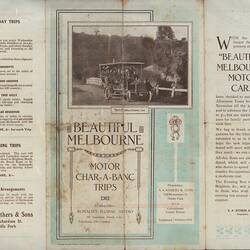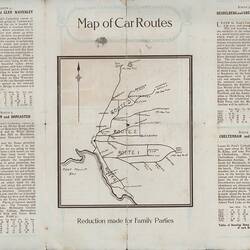Summary
Alternative Name(s): Brochure - Charabanc Journeys, Touring Omnibus, Motor Omnibus
Single-page flyer featuring an image of an early bus with open sides and covered roof, crowded with well-dressed passengers. Originally folded into three. The flyer, titled 'Beautiful Melbourne, Motor Char-a-banc Trips', advertises trips by charabanc radiating out from Melbourne. The company boasts '28 HP Milnes Daimler Cars'. The tours are operated by (Albert Arthur) A.A. Withers & Sons of 333 Richardson St, Middle Park, with bookings possible through Ronald's Floral Studio of 99 Swanston Street, City. His sons were Arthur, Ted, Syd, Peter, Percy & Reg.
Withers is offering Extended Afternoon Tours from 1 November to 30 April. 'We beg to thank our numerous patrons for the liberal patronage extended to us in the past, and hope the new trips now introduced meet with the success they merit...All-day Runs are also now introduced', as is an Evening Run. The evening runs travelled from South Melbourne to St Kilda along Beaconsfield Parade during the summer months.
Four afternoon routes are offered: Burwood and Glen Waverley; Blackburn and Doncaster; Heidelberg and Greensborough; and Cheltenham and Beaumauris. Each leaves St Paul's Cathedral corner in central Melbourne at 2.30pm and costs three shillings, with family discounts. The services run virtually every day of the week and sometimes twice per day. Calendar dates for departures are included, together with a map of the routes, crudely drawn.
The flyer details the attractions of each route. The Heidelberg and Greensborough route visits the Houses of Parliament, the Exhibition Building, the Gas Works, the Infectious Diseases Hospital in Fairfield, the Austin Home for Incurables at Heidelberg, and on the return journey the Bundoora Park Stud Farm and 'Mont Park Lunatic Asylum'. The Blackburn and Doncaster route continues the theme of insanity and gloom, with visits to the 'Yarra Bend Lunatic Asylums' [sic] and the Boorondara Cemetery.
The term 'lunatic asylum' was in official use in Victoria until 1903.
The flyer is not dated, but the style of the coach depicted is a pre-World War I model - possibly a 1911 petrol chassis Milnes-Daimler. This is one of four such vehicles acquired by Withers in 1911. One of the dates on the flyer is Sunday 18th February making 1912 the most likely date for the flyer.
Physical Description
Single-page flyer, printed on both sides in brown and pale blue on white. Front features image of early bus with open sides and covered roof, crowded with passengers. They are in a treed setting, passing over a bridge with white wooden railing. Beneath photo is title for flyer decorated with lines and floral patterns and a bow. Reverse of flyer has route map, hand-drawn, showing routes radiating out from Melbourne to the east. Includes route descriptions and timetables. Originally folded into three, the flyer has been folded several times more, and has dirt, tearing and losses along creases. Foxing overall.
Significance
The flyer is significant for the insight it provides into tourism in Victoria in the 1910s or 1920s. Apparently a rare survivor of an ephemeral advertising campaign, it details the routes and dates offered, offering a valuable resource for tourism research. The reach of the services out of Melbourne, as half-day trips, is of particular interest, as are the attractions identified for each route. It complements the more extensive photographic record of charabancs, held in collections at Museum Victoria and elsewhere.
Withers & Co advertised Char-a-banc trips from at least 1911 right through World War I (in spite of fuel shortages) and beyond. A.A. Withers' company is noted elsewhere as Pioneer Tourist Coaches Pty Ltd (for example, The Argus, 18 February 1924, page 9).
A. Withers (several of the Withers family were involved in the business) made a name for himself operating a range of charabanc services. On 14 September 1927, the Brisbane Courier reported (page 17) that he led a had party from Victoria 'on what is claimed to be the longest organised tour of its kind so far held in Australia'. The tour had 'arrived in Sydney in a Nash char-a-banc to-day after a visit to Central Australia. They left Melbourne on July 30, and since then have covered 4400 miles, visiting every Eastern State of the Commonwealth, and the Northern Territory. The tour was organised by Mr. A. Withers, of Melbourne, and his nephew, Mr. Alf. Withers, is driving the char-a-banc.'
A.A. Withers was a vocal proponent of the charabanc industry, too. On 27 June 1928, his letter published in the Argus (page 9) complained about the lack of licences issues to operate 'touring omnibuses' and notes that higher taxes have been imposed. He worries that 'this will have a serious effect on country tourist resorts, because the touring motor-omnibus has done much to keep tourists in Victoria, giving them an alternative to touring in other states.'
Charabanc travel could be risky, however. On Saturday 17 February 1924, a charabanc operated by Withers carrying 27 passengers overturned on the road to Mount Dandenong from Croydon, killing two women and injuring 12 others. A.A. Withers explained that it was the company's first accident, and that the type of coach used was not the same as that which was used 'for tourist trips to Sydney or the Alps'. It was a 'large International wagon', travelling the road for the second time that day. (The Argus, 18 February 1924, page 9)
More Information
-
Collecting Areas
-
Acquisition Information
Donation from Constance Tout-Smith, Jun 2010
-
Issued By
A. A. Withers & Sons, Melbourne, Victoria, Australia, 1910-1920
-
Inscriptions
Extensive printed text. Front section headed 'BEAUTIFUL / MELBOURNE / MOTOR / CHAR-A-BANC / TRIPS / Booking Office: / RONALD'S FLORAL STUDIO / 99 Swanston Street, City. / Telephone 1591 Central. / Proprietors: A.A. WITHERS & SONS / 333 Richardson St, Middle Park / or c/o / Government / Tourist Bureau / Telephone: Windsor 2681'.
-
Brand Names
-
Classification
-
Category
-
Discipline
-
Type of item
-
Overall Dimensions
315 mm (Width), 250 mm (Height)
-
References
Grace's Guide, British Engineering 1750-1960s, [Link 1] accessed 27/7/2011.
-
Keywords


